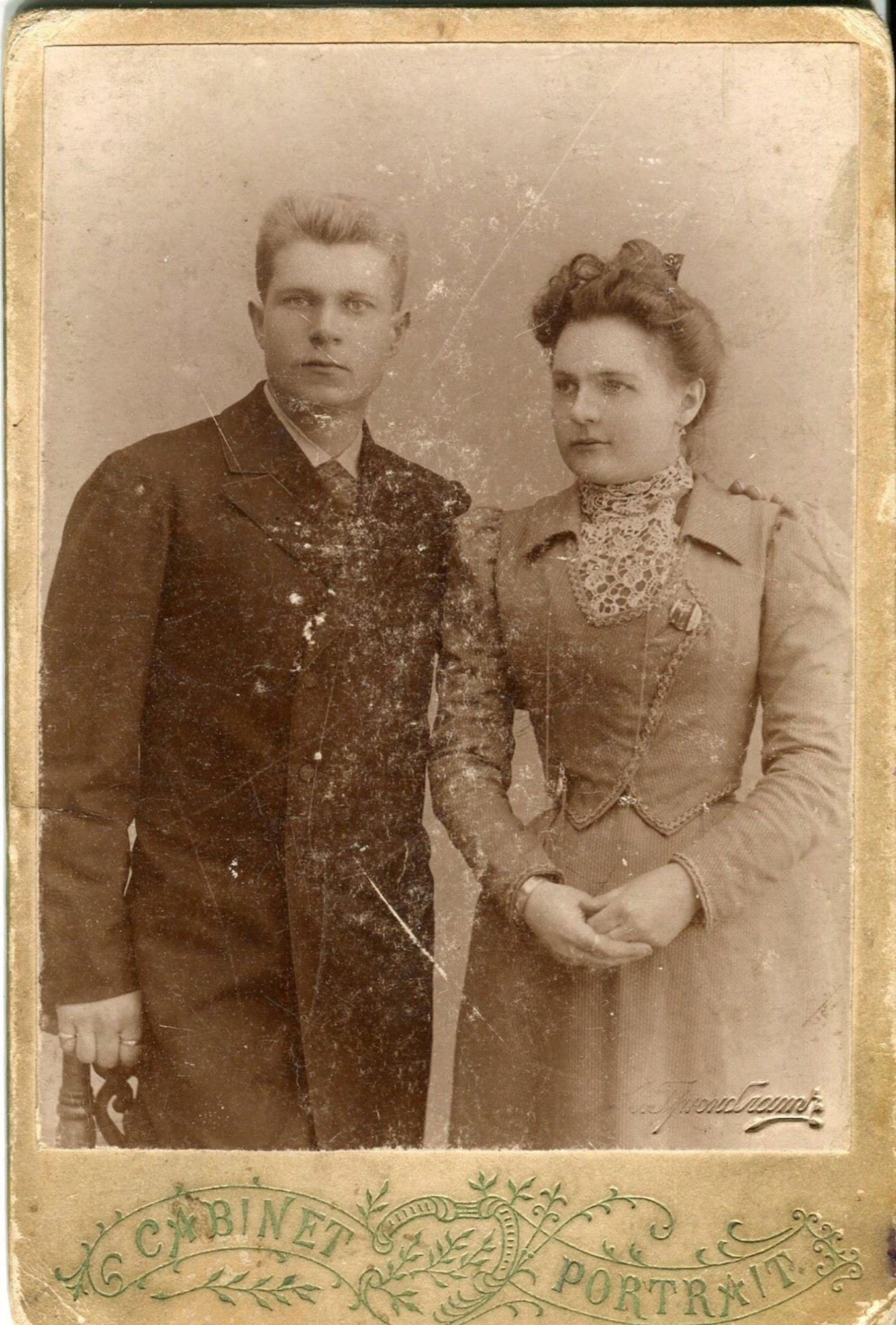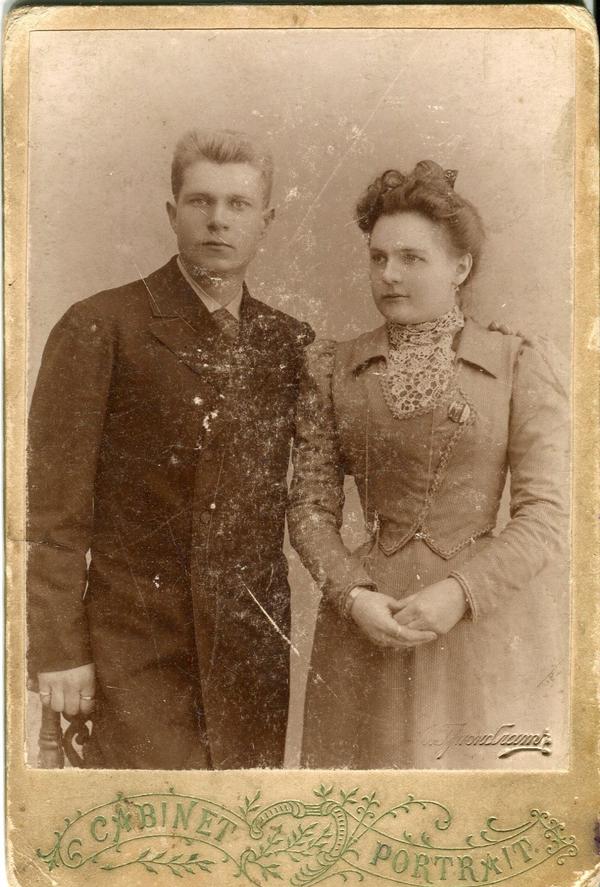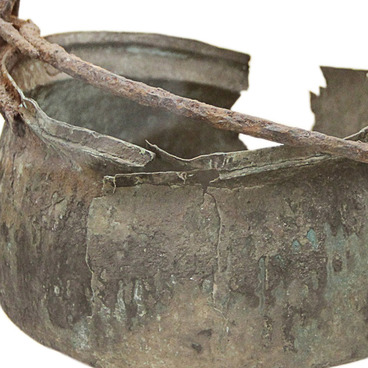The old photo shows a married couple, a man and a woman at the age of 25–30. The photo was taken in a studio. The border of the frame goes just above the knees of the models, which makes it possible to clearly see the faces and figures of the spouses.
The man in the photo is Afanasiy Petrovich Baykuzov, a locomotive driver, participant of the First Russian Revolution and the leader of the railway workers' movement at the Ruzayevka station, which is located at the intersection of large transport lines leading to the centre of Russia.
Afanasiy Baykuzov was born on 16 January 1873 in the town of Konotop in the Chernigov province. After finishing the city two-year school, he joined a handicraft locksmiths workshop, then the railway workshops - as an apprentice locksmith. At the age of 20, he got a job as an assistant driver at the Morshansk depot, and a year later he moved to the railway workshops of the town of Tula.
His military service in Baranovichi took two years. When Afanasiy returned, he got a job as an assistant driver in the railway depot of the town of Kursk, where he worked until 1900. At that time he met his future spouse Tatyana Kazimirovna (shown in the photo). In March 1900, having passed the exams, Afanasiy got the specialty of a locomotive driver and, in May of the same year, started working in this position at the Ruzayevka station. In November 1901, he was appointed to the position of chief driver and accompanied military trains.
Afanasiy Baykuzov left a bright mark in the history of the Mordovian Land with his participation in the Bolshevik movement. He headed the revolutionary committee of the Ruzayevka railway junction workers. On 10 December 1905 the Moscow Bolshevik Conference decided to hold a political strike. On the same day, a group of station workers and employees, led by Baykuzov, took power.
Activists organized a steering committee and assembled a squad of 150 people armed with firearms. The strike control center was in Ruzayevka, and the committee’s authority extended to nearby stations, junctions and villages. The forces of the squad maintained a strict order on the territory, and groups of workers guarded important objects.
The committee set firm prices for essential products and goods. Contributions were imposed on merchants and shopkeepers, the funds received were spent to organize catering in a free canteen. The workers even established the issue of own banknotes (bonds). Taking these receipts, merchants were obliged to release goods to railway employees on credit.
The small republic lasted only eleven days. At first, the strike was suppressed in Moscow, then repressions began on the Moscow – Kazan railway. On December, 20 the workers decided to finish the strike, and two days later Afanasiy Baykuzov was arrested and escorted to the Penza prison.
Tatyana Kazimirovna fully supported her spouse during the times of the ‘Ruzayevka Republic’. She took an active part in the committee and spoke at rallies. The gendarmes arrested Tatyana and sent her to prison together with their children. Afanasiy Baykuzov was sentenced to one and a half years of imprisonment, and after he was released he was sent to a settlement in Siberia. The family followed him.
The couple managed to return home only after the 1917 revolution. From 1924 to 1926 Afanasiy organized a factory apprenticeship school in Ruzayevka, and then became its director and teacher. In 1926 the family moved to Moscow. In the capital Baykuzov led the training plant at the Voitovich Carriage Repair Factory, and since 1938 he worked as deputy head of the Central Complaints Bureau of the USSR People’s Commissariat of Railways.
Afanasiy Baykuzov retired in 1943 but continued to engage in social activities. He helped a lot the collective farms (kolkhoz) in the Mordovian village of Pishlya, which was named after him back in 1930. Afanasiy Petrovich died in 1947 in Moscow, where he was buried.
The man in the photo is Afanasiy Petrovich Baykuzov, a locomotive driver, participant of the First Russian Revolution and the leader of the railway workers' movement at the Ruzayevka station, which is located at the intersection of large transport lines leading to the centre of Russia.
Afanasiy Baykuzov was born on 16 January 1873 in the town of Konotop in the Chernigov province. After finishing the city two-year school, he joined a handicraft locksmiths workshop, then the railway workshops - as an apprentice locksmith. At the age of 20, he got a job as an assistant driver at the Morshansk depot, and a year later he moved to the railway workshops of the town of Tula.
His military service in Baranovichi took two years. When Afanasiy returned, he got a job as an assistant driver in the railway depot of the town of Kursk, where he worked until 1900. At that time he met his future spouse Tatyana Kazimirovna (shown in the photo). In March 1900, having passed the exams, Afanasiy got the specialty of a locomotive driver and, in May of the same year, started working in this position at the Ruzayevka station. In November 1901, he was appointed to the position of chief driver and accompanied military trains.
Afanasiy Baykuzov left a bright mark in the history of the Mordovian Land with his participation in the Bolshevik movement. He headed the revolutionary committee of the Ruzayevka railway junction workers. On 10 December 1905 the Moscow Bolshevik Conference decided to hold a political strike. On the same day, a group of station workers and employees, led by Baykuzov, took power.
Activists organized a steering committee and assembled a squad of 150 people armed with firearms. The strike control center was in Ruzayevka, and the committee’s authority extended to nearby stations, junctions and villages. The forces of the squad maintained a strict order on the territory, and groups of workers guarded important objects.
The committee set firm prices for essential products and goods. Contributions were imposed on merchants and shopkeepers, the funds received were spent to organize catering in a free canteen. The workers even established the issue of own banknotes (bonds). Taking these receipts, merchants were obliged to release goods to railway employees on credit.
The small republic lasted only eleven days. At first, the strike was suppressed in Moscow, then repressions began on the Moscow – Kazan railway. On December, 20 the workers decided to finish the strike, and two days later Afanasiy Baykuzov was arrested and escorted to the Penza prison.
Tatyana Kazimirovna fully supported her spouse during the times of the ‘Ruzayevka Republic’. She took an active part in the committee and spoke at rallies. The gendarmes arrested Tatyana and sent her to prison together with their children. Afanasiy Baykuzov was sentenced to one and a half years of imprisonment, and after he was released he was sent to a settlement in Siberia. The family followed him.
The couple managed to return home only after the 1917 revolution. From 1924 to 1926 Afanasiy organized a factory apprenticeship school in Ruzayevka, and then became its director and teacher. In 1926 the family moved to Moscow. In the capital Baykuzov led the training plant at the Voitovich Carriage Repair Factory, and since 1938 he worked as deputy head of the Central Complaints Bureau of the USSR People’s Commissariat of Railways.
Afanasiy Baykuzov retired in 1943 but continued to engage in social activities. He helped a lot the collective farms (kolkhoz) in the Mordovian village of Pishlya, which was named after him back in 1930. Afanasiy Petrovich died in 1947 in Moscow, where he was buried.



